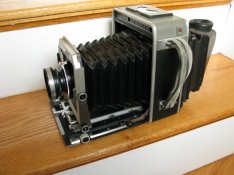So, buddyboy, you've probably discovered quite a bit since you first posted, but maybe I can pique your interest a bit on making the plunge:
1. Kodak and Fuji make b&w and colour 4x5 and 8x10 film. Ilford makes b&w sheet film in a variety of formats -- and will probably continue to for the foreseeable future. There are also a few Eastern European companies and Chinese companies that make b&w sheet film. Black and white film lasts decades in the fridge, too.
2. There are half a dozen companies that make large format view cameras and accessories, so new kits are definitely available. Sheet film holders were standardized a long, long time ago, so there are many view cameras still in service that are quite old, BUT NOT OBSOLETE.
3. A 4x5" sheet of film is 20 square inches of film. Has unbeatable resolution. Hundreds of megapixels. Quite a lot of commercial work is still being done with them.
4. This is cool: The lens plane doesn't have to be parallel to the film plane. We can correct perspective or adjust our plane of focus to suite the situation. And when you are examining the ground glass (under the dark cloth), you SEE the perspective, plane of focus, and depth of field (as you stop down). Can't do that with any other kind of camera. Great for architectural or macro work. This makes a view camera the most advanced and versatile photographic instrument available.
5. Many gorgeous printing processes are 'contact' processes, for which you need a large negative. Many of them can be done in the kitchen sink. Also, once you've developed your negatives, you can just contact print them on photo paper -- without an enlarger, even -- and frame (or give away) your 4x5, 5x7, or 8x10 prints. All you need is the camera, some film, paper, and simple chemistry.
6. If you are drooling over LARGE prints in galleries, they were probably made on a view camera.
7. Labs will process sheet film for you, but you can do your own b&w really cheaply with no special equipment. The chemisty will be available for a long, long time.
David.
P.S.
Why 'view' camera? The lens images the world (upside down) directly on the ground glass on the back of the camera. As opposed to 'reflex' cameras that use a mirror or prism to flip the image. There are 'twin lens reflex' cameras and 'single lens reflex' cameras, as well as 'range-finder' cameras. View cameras are the simplest, but require you to compose upside down.
keith, that's exactly what i meant! is that the same type of camera that david was referring to? what type of film is used? do i have to process it myself in my own dark room?
thanks!




















 .
. 